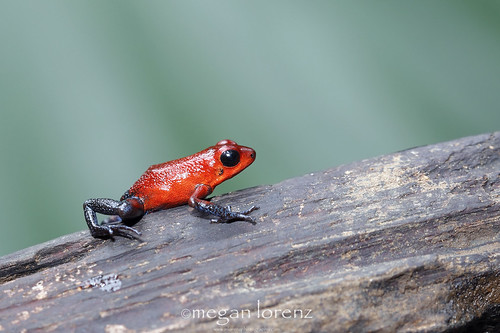Strawberry Poison Dart Frog
Costa Rica
The Strawberry Poison-dart Frog, also called the Blue-jeans Frog, is one of the most ‘popular’ amphibians in its region. This bright, charismatic species is active during the day and has a high population density, making its charming figure frequently found in certain areas of Costa Rica. This frog reproduces all year long in areas without a long dry season, and males can be heard calling all day with a buzz or chirp. Their small bodies can be seen or sometimes heard moving around leaf litter as they walk and hop.
Though small, males of this species are aggressively territorial. During the day, males perch on rocks, trees, or fallen logs, and make calls. These are both to attract females to mate as well as to intimidate trespassing males. If an intruder persists and calls back, a wrestling competition may result for up to 20 minutes. The males stand upright on their hind legs and grapple for dominance. Once one is pinned for several minutes he will leave after the winner releases him.
The fascinating reproductive process of this species has captured the interest of biologists and tourists alike. When a female meets a male, he leads her to a place to lay their eggs, such as in a curved leaf or in moist leaf litter. Unlike many frogs, the male does not climb onto the female’s back in amplexus, but instead the pair stands vent to vent, or with their tails together. The female lays 3 to 4 eggs, the male fertilizes them, and his mate leaves. The parental care beginning at this stage is unmatched by other amphibians. The male keeps the eggs moist by emptying his bladder on them. He also eats any eggs that are infected with fungi or that do not develop, as well as any eggs left by other males. Tadpoles hatch after one week, when the female returns. One to four tadpoles at a time squirm onto her back, and she carries each one to a different plant or leaf stem that is holding water—bromeliads are often the choice. These carefully chosen nests are sometimes in the canopy, high up from the frog’s otherwise ground-level habitat. Amazingly, the tadpole chooses its spot by vibrating when the mother approaches a desirable spot. Each tadpole is placed in a separate plant, where the mother leaves it with 1 to 5 unfertilized eggs for protein and nutrients. For more than a month, the female returns every few days to feed her young.
The frog’s bright colors warn off predators because the colors signal the toxicity for which the Poison-dart is named. The Strawberry Poison-dart Ffrog is not known to be lethal to man, but its skin secretions may have unpredictable effects on humans. Other species in this frog’s family have been used to make blowgun darts especially lethal. The most lethal animal toxin known belongs to a frog (Phyllobates terribilis) related to the Blue-jeans; poison from a single individual can kill twenty thousand mice or ten adult humans. Needless to say, brightly colored relatives like the Blue-jeans have few predators, and once it reaches adulthood, this frog can live for 5 or 6 years. As eggs, however, this species is preyed upon by fungi, worms, snakes, and even other Blue-jeans.
Aug 1, 2012
Blue Jeans
Subscribe to:
Post Comments (Atom)






No comments:
Post a Comment